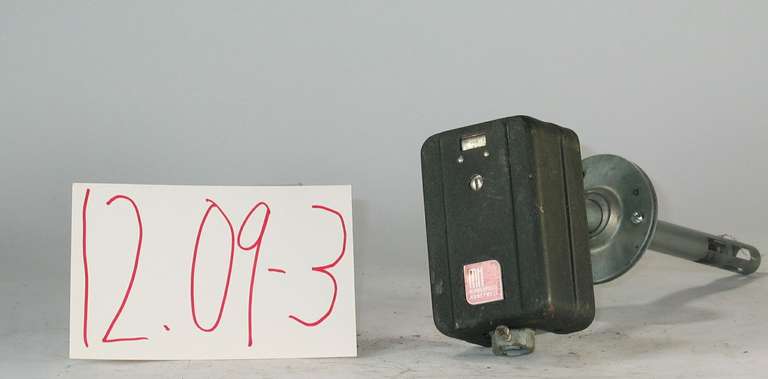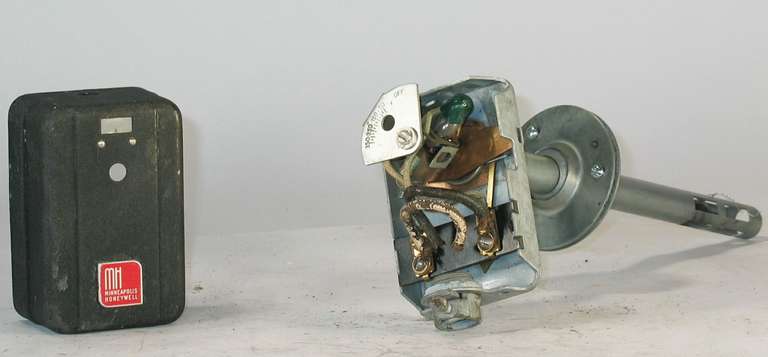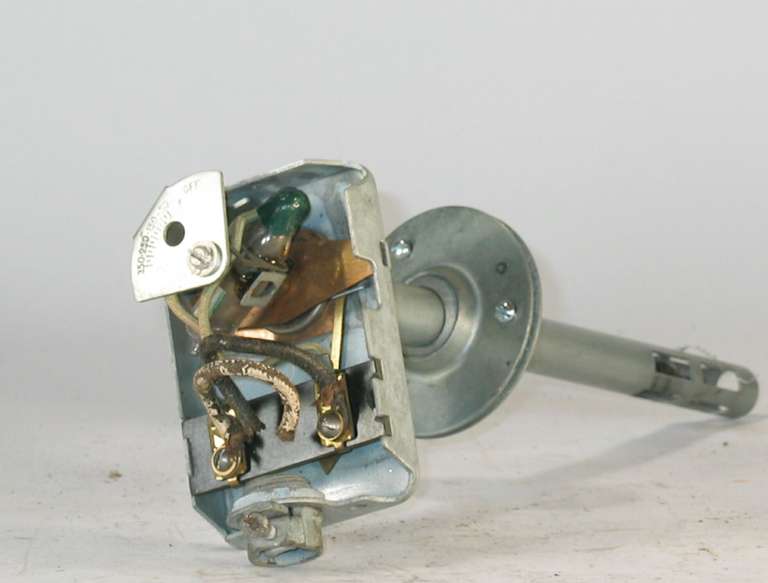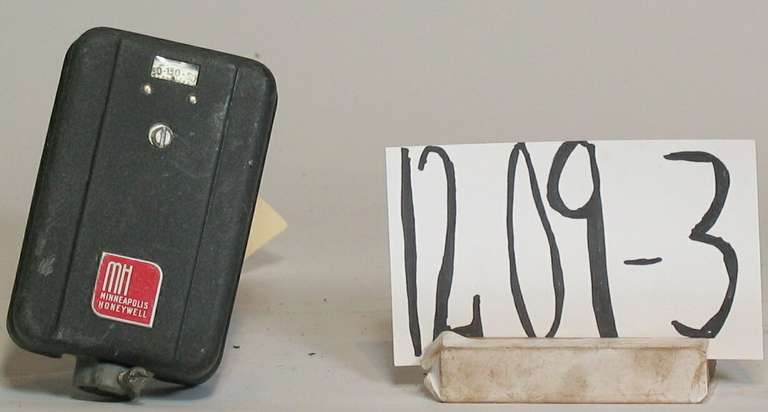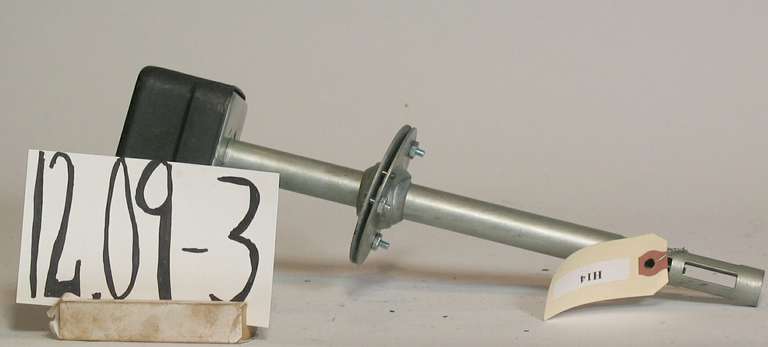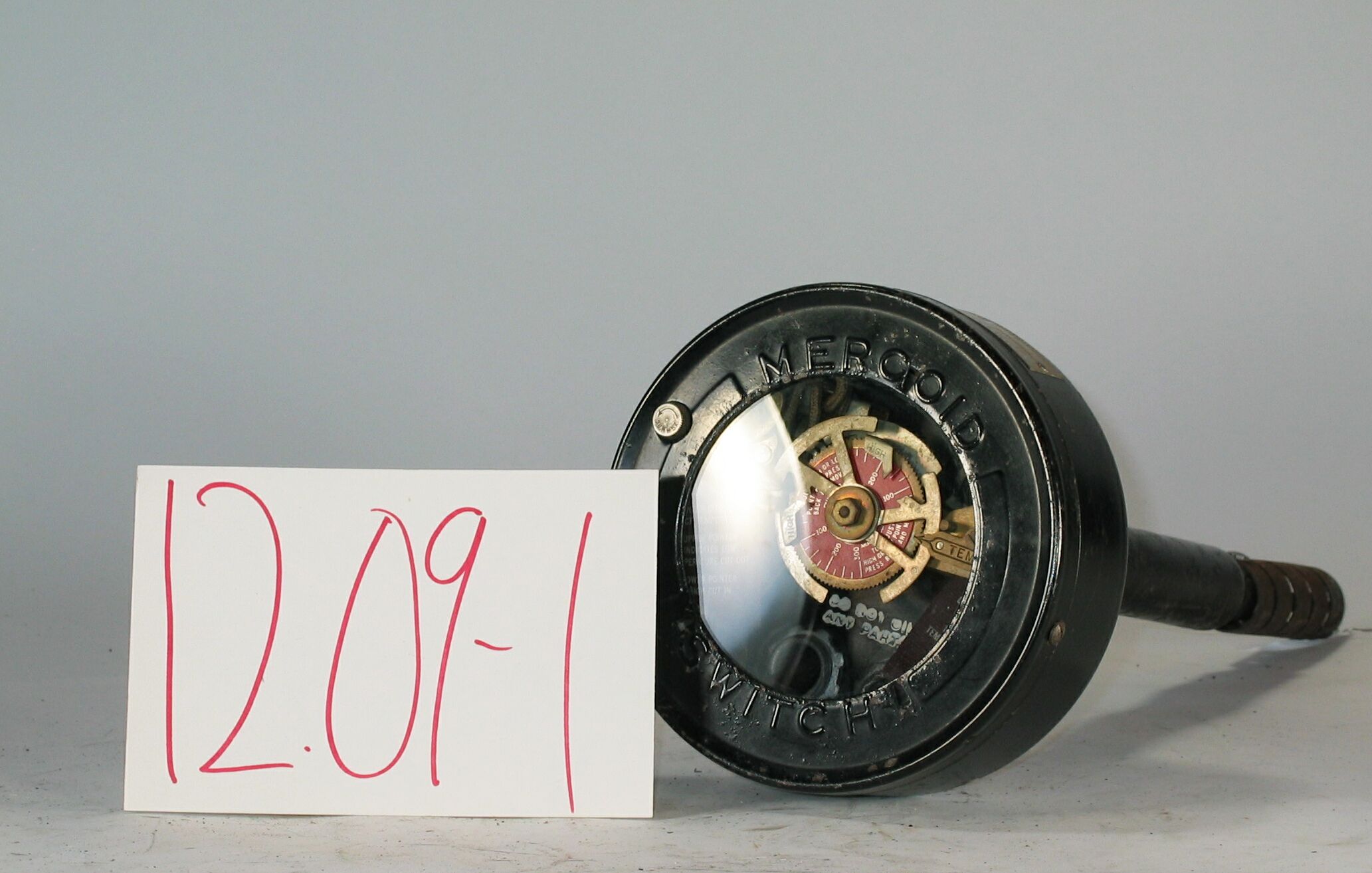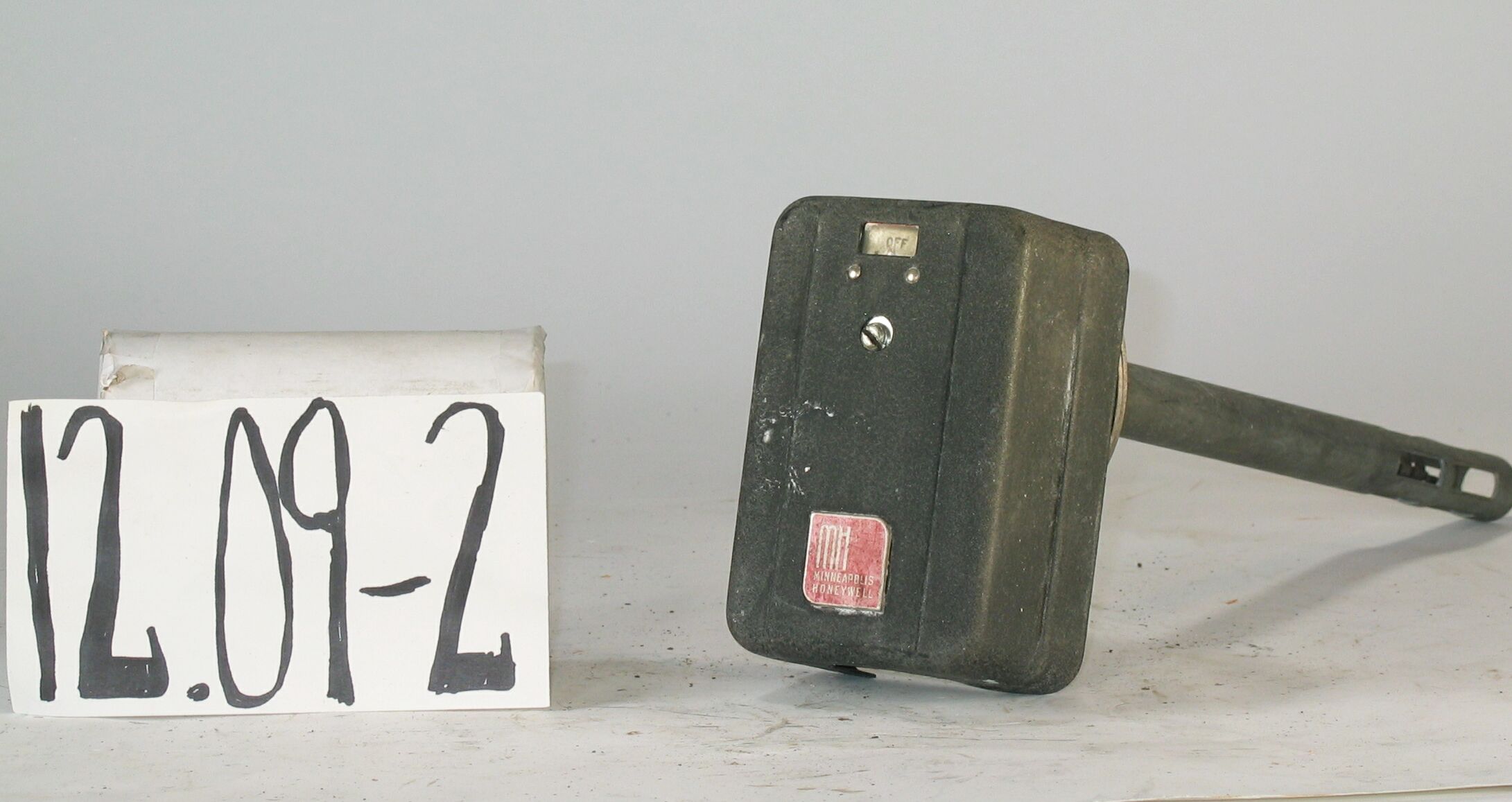12.09-3: Minneapolis Honeywell 1946 Temperature Safety Control
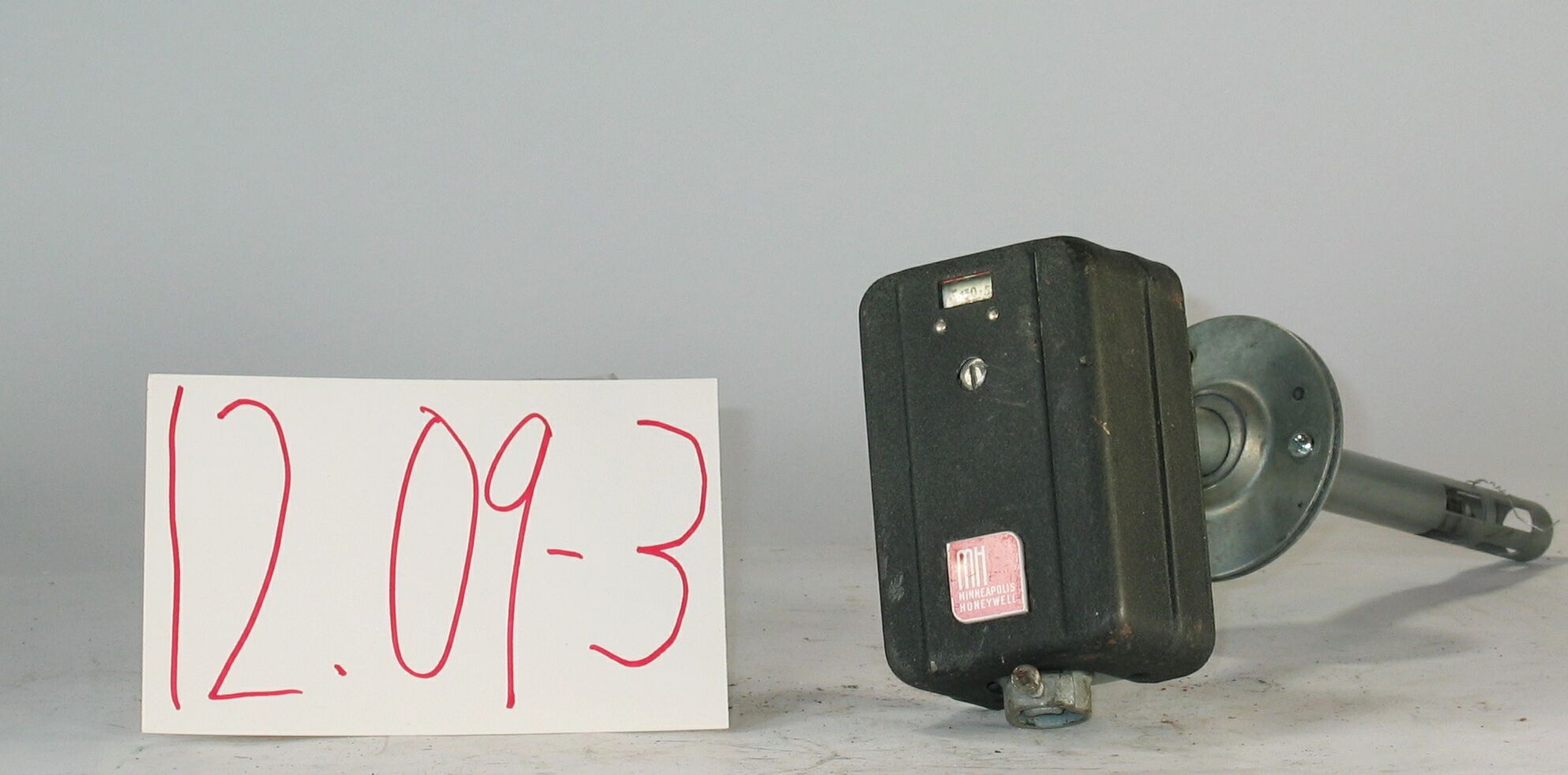
| HHCC Accession No. 2006.115 | HHCC Classification Code: 12.09-3 |
|---|
Description:
A mid 20th century, single function, adjustable temperature safety control for home ‘winter air conditioner’. Used for automatically shutting down the system to prevent over heating if, for example, the fan failed to come on allowing heat to build up in the furnace plennum beyond the safe operating point; equipped with helical bimetal heat sensor, single tilting mercury bulb line voltage switch, LA419, Minneapolis Honeywell, 1946 [1 of 2 similar to ID#238]
Group:
12.09 Pressure Atomizing Oil Burner Equipment and Systems ‘ Automatic Temperature Controls
Make:
Minneapolis Honeywell
Manufacturer:
Minneapolis Honeywell Regulator Co. Toronto 17
Model:
LA419A1X
Serial No.:
Size:
3 x 5 in x 13 in long
Weight:
3 lbs.
Circa:
1946
Rating:
Exhibit, education, and research quality, illustrating the engineering design of mid 20th century single function, automatic, air temperature cut off, safety limit controls for ‘winter air conditioners’ in Canada, to become the work horse of the field from the 1940’s through 60’s
Patent Date/Number:
Provenance:
From York County (York Region) Ontario, once a rich agricultural hinterlands, attracting early settlement in the last years of the 18th century. Located on the north slopes of the Oak Ridges Moraine, within 20 miles of Toronto, the County would also attract early ex-urban development, to be come a wealthy market place for the emerging household and consumer technologies of the early and mid 20th century.
This artifact was discovered in the 1950’s in the used stock of T. H. Oliver, Refrigeration and Electric Sales and Service, Aurora, Ontario, an early worker in the field of agricultural, industrial and consumer technology.
Complete with original T. H. Oliver tag, marketed used LA419, H limit, operation OK
Type and Design:
Equipped with helical bimetal heat sensor, Extended 10 in. temperature probe single, tilting mercury bulb Temperature calibration dial 50 to 350 deg, F Compression swivel mount
Construction:
Material:
Special Features:
Original cable connector Original wiring harness stubs Original label with wiring diagram and specifications
With original swivel compression mounting device allowing the postioning of the temperature sensor in the furnace hot air plennum
Accessories:
Capacities:
Performance Characteristics:
Operation:
Control and Regulation:
Targeted Market Segment:
Consumer Acceptance:
Merchandising:
Market Price:
Technological Significance:
A mid 20th century, single function temperature limit safety controller exemplifying the materials and engineering know-how of the immediate pre W.W.II years. The Post W.W.II market for ‘winter air conditioning’ was enormous and the industry sensed the potential, but there was still the public concern over the safety of all automatic equipment operating unattended in the home. The development of affordable, reliable high temperature limit automatic shut off control was a key to achieving market potential. Sales people, installers and service people would make a point of pointing out the safety features, why and how they worked. Some sales people would carry one of these safety controllers with them to clinch a sale.
Industrial Significance:
The simplicity of the controller is surely a hallmark of the times, reflecting sophisticated engineering and manufacturing methods, as well as the availability of the engineering materials needed
This controller may be one of the first class of products to be built in Canada by Minneapolis Honeywell, for the then rapidly growing market ‘ see dateline in side cover ‘Toronto 17’ Also made as a fan on-off controller, this series of limit safety controls by Honeywell would become the work horse of the industry throughout the major growth years of the winter air conditioner market in Canada, from the 1940’s through 60’s The original cable connector and wiring stubs tells the stories of the trade practices and materials of the times.
Socio-economic Significance:
With the introduction by the HVACR industry of forced air heating, a world change had taken place. It brought with it significant new market potential, for the replacement of central gravity, warm air heating systems, to be replaced with a new generation of modern automatic, central home heating equipment, dubbed the winter air conditioner. Public expectations were high, seeded in no small way by the marketing of the industry. With the development of the forced air furnace ‘the winter air conditioner’ came many new possibilities for winter comfort, automatic combustion control for solid and liquid fuels [coal and oil], automatic room temperature control, air distribution [well beyond that possible with natural convection], constant air circulation. air filtration, as well as automatic humidification . These features would be promoted by the warm air sector of the industry, as a competitive edge, over the ‘hot water heating systems [hydronic systems] of the times, once considered the preferred type of central heating for all that could afford it. During the 1940’s and 50’s the Howard Furnace Co of Toronto would be an acknowledged leader in the field of winter air conditioning equipment for the Canadian market, see reference. There promotion would read ‘Enjoy filtered, humidified, gently moving air throughout every part of your home’, ‘Have even temperature maintained in all rooms with lowest possible fuel costs and little attention”. This was surely new world experience for Canadians in the middle years of the 20th century
Socio-cultural Significance:
Donor:
G. Leslie Oliver, The T. H. Oliver HVACR Collection
HHCC Storage Location:
Tracking:
Bibliographic References:
Installation Instruction Types LA119, LA219 and LA419 Airstats, Mineapolis Honeywell, Nov 4 1946 Howard South-Wind, Air Conditioning and Heating Unit, Howard Furnace Co. Toronto, sale brochure, undated, circa 1940 Howard ‘Coal-Miser’ Air Heating Furnace, Howard Furnace andmanufacturing Co,, Toronto, sales brochure, undated, circa 1940. ‘Winter Air Heating and Winter Air conditioning’, John Norris McGraw-Hill 1950, Chapter 9, Humidity and the properties of Air.
Notes:
Related Reports:
CMX02, Item H14
